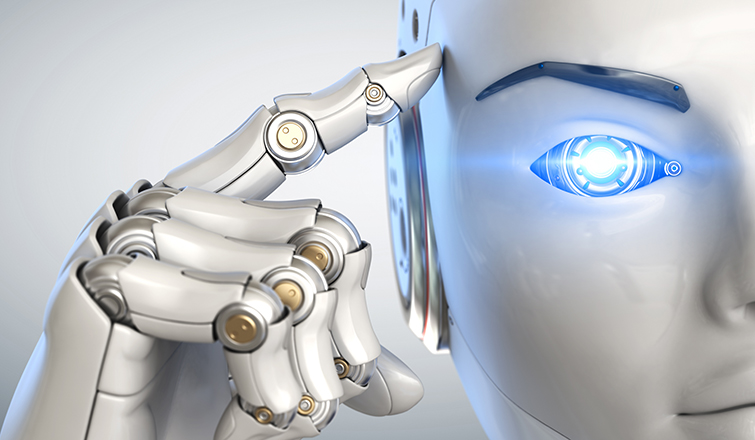 From Frank Herbert’s Dune to Blade Runner and Deus Ex Machina, Artificial Intelligence (AI) has long captured the human imagination. Usually, these works of fiction tend towards the dystopic. But not always: C-3PO from Star Wars is an example of benign and helpful Artificial Intelligence and this kind of AI may not be as far away as we think.
From Frank Herbert’s Dune to Blade Runner and Deus Ex Machina, Artificial Intelligence (AI) has long captured the human imagination. Usually, these works of fiction tend towards the dystopic. But not always: C-3PO from Star Wars is an example of benign and helpful Artificial Intelligence and this kind of AI may not be as far away as we think.
As in Star Wars, there’s a Light Side and Dark Side to current AI capabilities. Take digital assistants: according to Bill Gates, AI is “on the verge of making our lives more productive and creative.”1 Gates goes so far to say that, “In the future, an AI agent will know that you are at work and have ten minutes free, and then help you accomplish something that is high on your to-do list.”
While this sounds great, what Gates fails to acknowledge is that digital assistants have the potential to invade our privacy in new, unprecedented ways. At Hanu, we feel the best way to combat the Dark Side with the Light is to gain as much knowledge around the benefits one can reap from artificial intelligence as well as its potential for harm.
Defining Artificial Intelligence
Broadly speaking, Artificial Intelligence (AI) is the simulation of human or human-like intelligence by computers. This includes reasoning, learning and self-correction.
There are two subsets of AI: weak and strong. Weak AI is an AI system that functions at a level below or comparable to that of a human. However, weak AI is usually seen as not, by any definition, to possess consciousness. In contrast, strong AI possesses consciousness in the philosophical sense, with the potential to surpass human capabilities. To date, weak AI is the only variety which we have invented.
The last term that bears defining is Machine Learning (ML). ML is a subset of AI that the Harvard Business Review defines as a “machine’s ability to keep improving its performance without humans having to explain exactly how to accomplish all the tasks it’s given.”
Now that we’re on the same page, let’s dive into an overview of the ways in which AI is currently being used.
AI and Healthcare: The Light Side at Its Best
AI is poised to transform healthcare as we know it. Indeed, it’s already begun: telehealth and remote nursing have begun to use AI computers on the frontlines, providing initial health advice as well as documenting patient data in a centralized repository so that it can be referred to by medical professionals later.
It’s very likely that we’ll see a surge in responsive medicine, where medical facilities will be fitted with AI-powered diagnostic monitoring equipment. This equipment will monitor patient condition, scour medical databases for diagnostic information and report back to both doctors and electronic health records. These machines will give doctors the best information with which to compare and contrast conditions to arrive at a conclusion. Some of these solutions have already been put into practice and are saving lives. If you’re interested in implementing AI solutions in your organization, see what Microsoft Azure has to offer.
Business Intelligence: Assessing and Actionizing Big Data
One of the most useful applications of AI is in business intelligence (BI). We’re already seeing this happen on multiple fronts. One example of this is Power BI on Microsoft Azure. Power BI is the Holy Grail of business analytics for non-technical business users looking to take advantage of big data in an actionable manner. Anyone familiar with Excel will feel right at home and will be able to aggregate, analyze, visualize and share actionable business data in hours. Previously, accessing data in this manner would require external teams, representing a significant investment in both time and money.
Social Media and Marketing: An Example of the Perils of the Dark Side
It’s safe to say that AI has transformed social media marketing. Where previously marketers were only able to target a few buyer personas based on a handful of broad demographic categories, they are now able to create hundreds of segments characterized by thousands of data points. AI enables predictive analytics that can be used to define audience segments, allowing for far superior targeting capabilities.
But there’s a potential downside to this. Most people are aware of foreign involvement in the 2017 US Presidential election. Using 50,000 to 60,000 message variations, these bad actors were able to target thousands of “psychotypes” on Facebook very effectively.2 Regardless of how you feel about the outcome of the election, foreign meddling in American politics is most certainly a manifestation of the Dark Side of AI.
In the next installment of this series, we’ll delve into the dark side of AI and ML as well as some of the ways in which we can avoid straying from the Light. Additionally, don’t miss future articles where we’ll discuss more practical applications of AI such as self-driving cars and blockchain.
Contact us to learn how we’re enabling businesses to efficiently leverage AI and ML solutions using Microsoft Azure.
Sources



